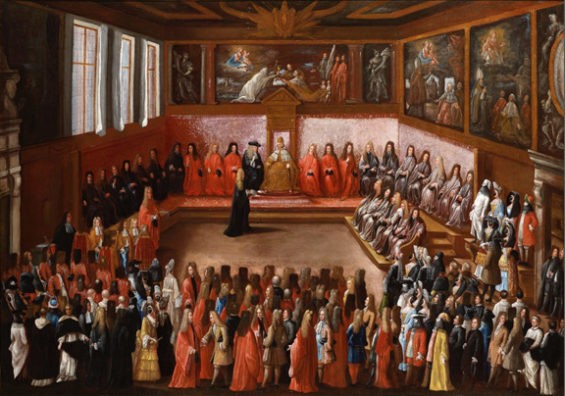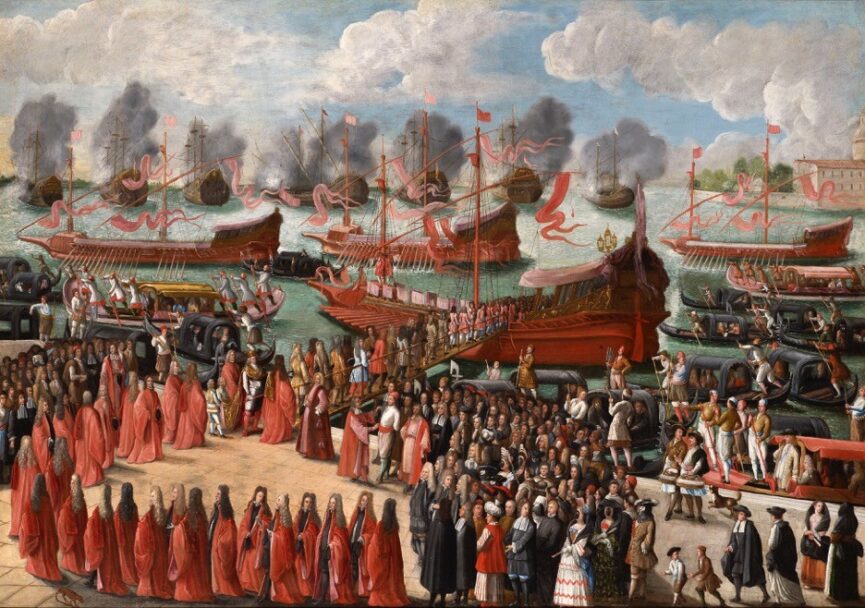ALESSANDRO PIAZZA
(Venice circa 1665 – circa 1727)The Doge receiving an Ambassador in the Sala del Collegio of the Doge’s Palace; A Doge embarking as Captain of the Venetian Fleet; a pair
Oil on canvas: 48 x 68 in. 122 x 173 cm.
John Julius Norwich has kindly written of ‘The Doge Embarking’ “But the Embarkation is simply magnificent. I think it almost certainly represents the departure of Doge Francesco Morosini on his Greek campaign in 1685.”
Though traditionally given to the Venetian painter Joseph Heinz, both Dario Succi and Maria Celeste Cola have now convincingly attributed the pair of canvases to the Venetian painter of ceremonies Alessandro Piazza. Professor Succi has stated that the pair are certamente by the hand of Piazza, and will include them in his forthcoming volume on Vedute di Venezia 1680-1880. As John Julius Norwich kindly pointed out one work depicts the embarkation of the Doge Francesco Morosini (1619-1694), so the two pictures almost certainly belong to the views of seven episodes in the life of Morosini in the Museo Correr, Venice. These were just the kind of ceremonial celebrations in which Piazza specialised. Although he executed four outstanding views of the Venetian lagoons, now in the Worcester Art Museum, he achieved fame in his native city from the thirty-four canvases representing Venetian festivities, games and tournaments recorded at the end of the seventeenth century in the villa of Daniele Dolfin on the terrafirma.
Moving to Rome in the first years of the eighteenth century Piazza settled in a house in the parish of Santo Stefano del Cacco. Here he successfully pursued his career as vedutisto with large-scale pictures celebrating important events, such as the two canvases from the Barberini collection now the Museo di Roma, as well as the Grand Procession of Pope Clement XI which was recently on the art market and fetched 161,000 euros. In the eternal city the artist’s main clients were the Ruspoli family, arrived from banking in Florence to establish themselves as one of the leading sources of patronage in Rome. Piazza was chosen by Francesco Maria Ruspoli to execute the large canvas of the Reggimento in partenza per Ferrara, after the blessing of the Pope at the Quirinale. Interestingly the view shows not just members of the Ruspoli family, but one of their court composers George Frederick Handel. The painting was commissioned in 1710 and completed in December of that year.Transferred to the palazzo Corso in 1714 it was eventually displayed in the Sala Nobile to celebrate the memory of the campaign against Ferrara and bonds between the Ruspoli and ClementXI’s family the Albani. It was this alliance and support for the Pope that raised the Ruspoli from the status of Marchese to Principe.
Our pair of recently re-united scenes were probably executed, together with the series in the Museo Correr, around 1700. The historical context is as follows: in January 1684, after lengthy debate, Venice decided to join the League formed by the Emperor Leopold against the Turks. The Imperial ambassador was summoned before the Collegio and informed of the decision. The Doge at this time was the recently elected Marcantonio Giustinian, but more importantly the Captain-General was Francesco Morosini, who led the Venetian fleet on a series of successful raids on Turkish strongholds on the Dalmatian coast in 1685. As a result he was elected Doge to succeed Gustinian in 1688, and despite illness again embarked at the head of his fleet in 1693.
John Julius Norwich inimitably describes the scene in A History of Venice: “The day before he was due to embark, Wednesday, 24 May 1693, he marched in solemn procession to the Basilica, splendidly robed in the gold-embroidered mantle of Captain-General, baton in hand. Many of his subjects, we are told, objected to the baton ‘as too manifest a sign of authority in a free and republican city’…On the following day, escorted as before by his carabiniers and halberdiers, his standard-bearers, military band and trumpeters, the Patriarch and clergy, the Signoria, the Procurators of St Mark, the Papal Nuncio and foreign ambassadors, the Senate and finally his family and friends, he proceeded in state from the Zecca at the corner of the Piazetta, along the Riva to the furthest extremity of Castello, where the Bucintoro waited to carry him across the lagoon, through a dense throng of exuberantly decorated gondolas, first to S.Nicolo on the Lido for a last prayer before anchor was weighed and the ship, with her sails set and the Lion of St Mark at her prow, headed out through the Lido port towards Malvasia, where the main body of the fleet was already gathered.”
These teeming views, crowded with the great and the good of Venetian society, therefore join the Correr and Roman series as high-points in Piazza’s magnificent records of some the great ceremonies of the age. In this respect they are the forerunners of Carlvarijs’s panoramic works celebrating the arrival of ambassadors to Venice, and of Canaletto’s famous images of the marriage of the Doge to the sea.


